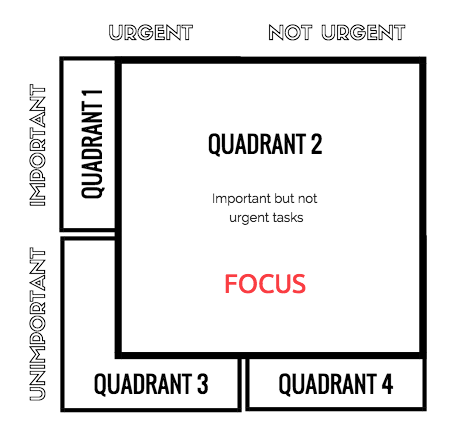The TMM also lessens stress and improves fulfillment in all areas of life
Ready for a simple-to-use time management tool that will change your life? What If I told you that by using it you could:
- Accomplish more of what you’d like to accomplish on a daily basis
- Experience less stress
- Feel more freedom and fulfillment
- Minimize major crisis situations
- Be more planned and intentional with what you do each day
- Move your life into a future that inspires you
Sound good? I consider this little hack – called the Task Management Matrix (TMM) — a real game-changer.
The TMM is a grid with four quadrants that you can use as a guide for dividing your daily tasks. It doesn’t look particularly sexy, but trust me when I say it will produce crazy results for you.
The grid helps you focus on what you want to achieve in life, and then helps you automatically distribute your daily tasks intelligently, so you progress in the areas that matter most.
How to use the Task Management Matrix
The TMM was originally designed and used by President Eisenhower. He’s credited as the most productive president in U.S. history and likely it’s because he used this tool each morning to decide what tasks to do when. I’ve added an additional step to further improve his formula.
Here’s what the Task Management Matrix looks like:
If you’ve never seen this before, don’t let it intimidate you. It’s easy to use. All you have to do is consider all your tasks for the day and divide them by quadrant.
You’ll want to distribute your time so you spend approximately 65% on tasks that fall in Quadrant 2. To better understand why and how to use it let’s consider the most common time management errors that most people fall into.
Common task and time management errors
Many people spend the majority of their time in Quadrant 1. If that’s you, it means you mainly engage in tasks that are IMPORTANT AND URGENT. In other words, tasks that require your immediate attention and contribute to some long-term goal or commitment in life. Activities like:
- Delivering a work project by a short deadline
- Calming a crying baby
- Seeing your doctor to get a plugged ear de-waxified
- Cleaning out a moldy kitchen fridge

Yes, these are important things to do, but spending most of your time here is a trap that’s easy to fall into. Humans are hardwired to manage short-term disasters first. It’s how our early ancestors survived.
But the brain doesn’t delineate, which is why we can sometimes fall into a trap of living a life where we are always “putting out fires”. That means, we get into a routine of always reacting to crisis, versus doing what needs to be done to ensure the crisis never happens in the first place.
The problem with focusing your energy on tasks in Quadrant 1 means you are always reacting to life. You are always rushing to finish or fix something. You’re thinking can become narrow with no concern for the long-term future. You end up doing what needs to get done today with no regard for the fact that your present actions will dictate the future you are living into.
You can’t avoid Quadrant 1 altogether. There are times where crisis situations arise around you that are not under your control. For example, if your boss drops a project for a multi-million dollar client with a two-week deadline on your desk, it’s in your best interest to comply, even if you don’t exactly want to (especially if you want to keep your job!).
But, the way you work is on you.
You can be someone who rushes last minute the night before. Or, the moment you receive the project you can spent some time planning your hours of work over the two-week time frame to ensure you’re not rushing and have time to do your best work. Which person would you rather be?
Now, if you spend most of your time on UNIMPORTANT BUT URGENT tasks you might spend most of your time in Quadrant 3. These are activities that don’t further your progress into the future you desire to create for yourself. Tasks such as:
- Dropping what you are doing to help a friend or family member do something that requires immediate attention and is important to them but doesn’t further your life
- Going to a job you hate every day without making plans to change your career
- Responding to personal text messages or emails that get in the way of important tasks
If the majority of your time is spent in Quadrant 3 you’re likely busy yet you often feel like you’re not getting anywhere in life.

What’s worse is spending most of your time in Quadrant 4. If you spend most of your time having fun, engaged in activities that make you feel good, but don’t forward your life in any productive way, you’ll likely have an enjoyable life, but limited achievement. These activities are primarily distractions. You may find yourself feeling unfulfilled. Do you do these things often?:
- Watch TV
- Play video games
- Browse the web or social media
- Shop
- Gamble
- Knit matching sweaters for your dogs
This not to say that you shouldn’t engage in fun. It’s very important for your mental health. But, if you have too much fun it doesn’t forward your overall commitments.
How to manage your life so you feel relaxed, organized, “on top of things”, and you get where you want to in life:
If you spend most of your time in Quadrant 2 – then, BRAVO! If not, you might want to try this right away:
Spend approximately 65% of your time engaged in activities that are IMPORTANT but NOT URGENT. Tasks that fall into this category include:
- Relationship building
- Recreation
- Creating action plans
If you do this, you’ll minimize crisis situations because in many cases you’ve already taken care of these issues before they have time to develop into major problems. For instance, if you throw out expired food on the day it goes bad you’ll be able to avoid the dirty, moldy, stinky fridge.
Ideal distribution of tasks would look like this:
Here’s what’s crucial, before you divide all your to-do’s for the day into the four quadrants you need to remind yourself of what you are committed to in life and what specific outcomes you’d like to achieve that day. This will help you ensure that your daily tasks are aligned with where you’d like to guide your future.
For instance, if you’d like to improve your physical fitness, you’ll need to make sure you remind yourself of that commitment to ensure you incorporate daily fitness tasks into your schedule.
Therefore, prior to filling out the matrix and distributing your daily tasks you’ll need to answer the question “What outcomes am I committed to achieving in today? ” for all areas that contribute to your well-being.
Use the Task Management Matrix for at least one day, and up to one week. It can take as little as 15 minutes for you to divide your task at the beginning of your day.
I guarantee if you use it even just one day you will see it’s tremendous value.
Grab a printable PDF version of the grid here with step by step instructions.















 Of course he brought the most extensive dictionary in the world. It was just like him to do so. I was aggravated. I thought: “How could a person be so perfect, so put together all the the time?”
Of course he brought the most extensive dictionary in the world. It was just like him to do so. I was aggravated. I thought: “How could a person be so perfect, so put together all the the time?”
